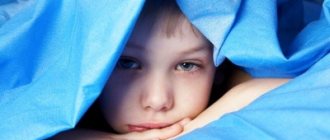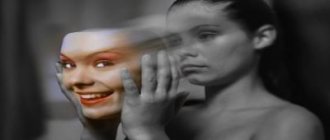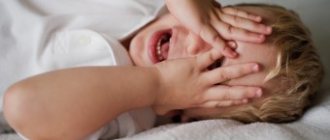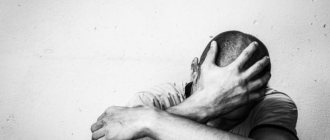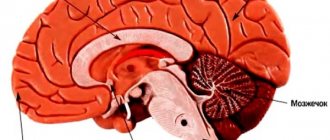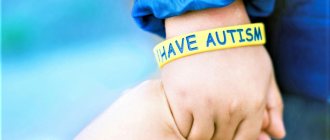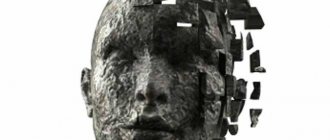Mania should be distinguished from hypomania, the presence of which is acceptable in the clinical picture of recurrent depressive disorder. Episodes of hypomania are observed when recovering from a depressive state, and are often provoked by treatment with antidepressants (phase inversion). However, if we have depressive periods that alternate with manic episodes (a significant increase in mood up to euphoria, high physical and mental activity, disinhibition of desires and drives), then it is necessary to diagnose bipolar affective disorder (BD).
At the moment, there are no instrumental methods for determining depression. Doctors use an exclusively clinical approach and psychopathological examination during a conversation with the patient. As an auxiliary option, various scales are used to determine the level of depression (Beck scale, Montgomery-Asberg scale, Hamilton scale, hospital scale).
Clinical scales are effective for monitoring possible affective states, both depressive at different levels of depression, and possible hypomanic states that may arise during treatment. But using them as the only method for diagnosing depression is not advisable. After all, nothing can replace a conversation with a doctor, during which the specific medical history, complaints, problems with sleep, nutrition, connections with traumatic factors, suicidal urges, etc. are clarified. That is, depression has its own clinical characteristic picture.
Characteristics and forms of the disease
Recurrent depressive disorder differs in its course. This form is characterized by recurrent episodes of depression, which have typical symptoms, but there should be no independent periods of increased mood in the medical history, although there may be short episodes of improvement, sometimes due to the use of antidepressants. The duration of one depressive attack can be very different, from two weeks to many months, after which a period of remission begins without the manifestation of depressive symptoms. This includes seasonal affective disorder. This disease has different forms and can occur with varying degrees of severity of symptoms:
- in a mild case, a depressive episode is accompanied by mild symptoms, with no bursts of energy;
- moderate course is characterized by moderate manifestation of depressive symptoms without energy boosts;
- in severe cases, the attack can take the form of major depressive disorder, endogenous depression, manic-depressive psychosis, vital depression.
This type of disorder should be distinguished from recurrent transient depression, where mental episodes are short, from two days to two weeks, and are repeated approximately once a month throughout the year.
Disease history
Information about depression as a disease has appeared only recently. In the time of Hippocrates, melancholy was associated with the predominance of “black” bile in the body. Of course, diagnostic methods gradually improved, and by the Middle Ages, theologians came to the conclusion that people subject to despondency were possessed by the devil. Accordingly, they tested on the poor people their entire wide arsenal of means for carrying out the rite of exorcism. They used holy water, prayer, strict fasting and even torture.
Fortunately, the Renaissance came, and with it, such fundamental sciences as medicine, physics, and mathematics received a second life. A scientific approach to everything was encouraged. Since that time, neurology and psychiatry began to consider low mood as a recurrent depressive disorder. The history of the disease goes back many centuries. Various approaches to solving the problem have been proposed, but it has not yet been completely cured.
Features of the course of the disease and the causes of its occurrence
Statistics show that women suffer from this disease twice as much as men. Recurrent depression most often appears quite late, after 40 years, and sometimes much later. The average length of an episode is 6–8 months, and the remission period lasts more than eight weeks without the person experiencing significant mood symptoms. In old age, chronic depression is sometimes diagnosed during the interictal period. It is very difficult to identify the true causes of this depressive mental disorder, however, it is possible to identify the main factors influencing the occurrence of the disease:
- genetic predisposition or other endogenous factors. In 35% of cases when depression occurs, there are no external causes at all;
- psychogenic reasons. The disorder is caused by excessive brain overload due to stress, which is caused by mental trauma or other psychosocial factors;
- organic causes are associated with the consequences of any traumatic brain injury, intoxication, neuroinfections, etc.;
- if it is seasonal depression, then its occurrence may be associated with a deficiency of serotonin and other neurotransmitters.
Typically, the first depressive episode of a recurrent disorder occurs as a result of external traumatic factors, and repeated ones, on the contrary, are rarely caused by external causes.
Prevalence
At least once in our lives, each of us has experienced a state of depression. But hardly anyone bothered to see a doctor for such an insignificant reason. Nothing hurts, and that’s okay. In developed countries, depression is one of the main causes of disability. This diagnosis is more common among residents of large cities, because in the “human anthill” you can feel lonely like nowhere else. Overcrowding, poor environment, constant stress, excessive demands on oneself and the desire to succeed certainly put pressure on the human psyche, causing it to experience overload. The fact that people living in cities are more likely to decide to go to the doctor and find out their diagnosis also plays a role.
Somatic, especially neurological diseases increase depression. Constant headaches or heart pain can make a person think about his imminent death. Overly strict upbringing, stress and trauma in early childhood, and episodes of domestic violence also play a big role. Heredity also plays a role. So, if close relatives have such conditions as bipolar disorder, schizoaffective disorder or depression, then the likelihood of it in the offspring is much higher.
Symptoms of recurrent depression
In their structure, mental attacks correspond to a classic depressive episode. They are characterized by a triad of main symptoms of depression: 1) low mood, inability to feel pleasure from usual activities; 2) increased fatigue, motor lethargy, lack of energy; 3) disturbances in judgment and thinking with a bias towards the pessimistic side. Everyday stressful situations can negatively affect the severity of recurrent attacks. Also, recurrent depressive disorder is characterized by a number of additional affective symptoms:
- a person may have an unreasonable feeling of guilt, condemnation of his activities;
- the patient becomes less confident and his self-esteem decreases;
- the ability to concentrate decreases;
- suicidal tendencies and thoughts of causing any harm to oneself may appear;
- sleep-related disorders: insomnia, nightmares, anxiety;
- there is often a decrease in appetite;
- a person is visited by gloomy thoughts about the prospects for his future.
During different episodes, symptoms may vary in nature and severity.
Diagnosis of the disease
The main criterion for diagnosing recurrent depression is the detection of at least two attacks lasting more than two weeks. Moreover, a couple of months in a row must pass between attacks without the manifestation of obvious symptoms of a mental disorder and deterioration in mood. When diagnosing the current episode, the severity level of the disorder is determined: mild, moderate, severe. With a mild degree, a person must have at least two of the main symptoms plus any two additional ones. If, with two main symptoms, three or four additional symptoms are detected, then the disorder is classified as moderate in severity. In severe cases, the patient has all the main symptoms, as well as more than four additional ones. If a patient has a history of manic episodes, a diagnosis of bipolar affective disorder is made. When using differential diagnosis, it is necessary to exclude any form of schizophrenic disorder, as well as affective disorders that are organic in nature, for example, brain tumors, encephalitis, endocrine disorders. Recurrent depressive disorder cannot be identified using psychological methods at home. The diagnosis can only be made by a qualified specialist in a clinical setting.
Features of the disease
Like any disease, RDD has its own characteristics:
- acute periods are repeated several times, more often in the cold season;
- the disease develops more often in women than in men;
- in the absence of appropriate treatment, it can develop into bipolar affective disorder.
There are 3 degrees of severity of the disease:
- mild, when the patient is able to perform professional and household duties and retains social functions;
- medium, when the sick person can work and communicate, but with great difficulty;
- with a severe degree of the disease, a person is not able to get out of bed, eat, drink, and is constantly overcome by suicidal feelings.
In addition, in psychiatry, a distinction is made between melancholic and anxious RDD.
Treatment and prevention of recurrent depression
When choosing a treatment method, it is very important to conduct a complete preliminary examination of the patient and make the most accurate diagnosis. Recurrent depression is treated mainly in three ways: medication, psychotherapy and ECT (electroconvulsive therapy).
The latter method is used only in very severe cases. The most effective is considered to be a combination of psychotherapeutic techniques with antidepressants. However, to treat milder forms of recurrent disorder, psychologists consider behavioral and cognitive therapy sufficient. With drug therapy, in addition to antidepressants, inhibitors, antipsychotics, and benzodiazepines can also be prescribed. Regardless of the chosen treatment method, it is important to understand that recurrent depressive disorder takes a long time to be treated, and therapy should not be interrupted under any circumstances without the doctor’s permission. In addition, after the attack is suppressed, many patients are also recommended maintenance therapy, which sometimes includes lithium or other drugs. The main goal of preventing recurrent depression is to reduce the frequency of attacks and prolong the period of remission. To do this, it is necessary to minimize stress factors that can affect the patient in everyday life, as well as periodically visit a psychiatrist to prescribe preventive treatment.
Recurrent depressive disorder
- a disorder characterized by repeated mild, moderate, or severe depressive episodes, without anamnestic evidence of individual episodes of elevated mood, hyperactivity, which could meet the criteria for mania. However, this category can be used if there is evidence of brief episodes of mild elation and hyperactivity that meet the criteria for hypomania that immediately follow a depressive episode (they can sometimes be precipitated by treatment for depression).
The prevalence in the population is quite high and, according to various sources, ranges from 0.5 to 2%
What causes recurrent depressive disorder:
As a rule, it is quite difficult to identify the exact cause of recurrent depressive disorder; the main etiological factors include: endogenous (genetically determined predisposition), psychogenic (depression is the most typical human reaction to mental trauma) and organic (residual organic inferiority, consequences of neuroinfections, intoxication, head injuries, etc.). The first episodes of recurrent depressive disorder are usually caused by external provocation (usually traumatic circumstances), but the occurrence and development of repeated phases is dominated by factors not related to external circumstances.
Pathogenesis (what happens?) during Recurrent Depressive Disorder:
The first episode occurs later than in bipolar disorder, around age 40, although the illness often begins much later. The duration of episodes is 3-12 months (average duration is about 6 months). The period between attacks is at least 2 months, during which no significant affective symptoms are observed. Although recovery is usually complete between attacks, a small proportion of patients develop chronic depression, especially in old age. Typically, by late age there is a prolongation of attacks. There is a fairly distinct individual or seasonal rhythm. The structure and typology of attacks correspond to endogenous depression. Additional stress can change the severity of depression. Individual episodes of any severity are often provoked by a stressful situation and, in many cultural conditions, are observed 2 times more often in women than in men.
Symptoms of Recurrent Depressive Disorder:
Main symptoms
- depressed mood;
- decreased interest or pleasure in activities that the patient previously enjoyed;
- decreased energy and increased fatigue.
Additional symptoms
- decreased self-esteem and sense of self-confidence;
- unreasonable feelings of self-condemnation and guilt;
- ideas or actions aimed at self-harm or suicide;
- decreased ability to concentrate and pay attention;
- a gloomy and pessimistic vision of the future;
- sleep disturbance;
- change in appetite.
Diagnosis of recurrent depressive disorder:
The main feature of recurrent depressive disorder is the presence of recurrent depressive episodes (at least 2 episodes must last at least 2 weeks and must be separated by an interval of several months without any significant mood disturbances). The possibility of a manic episode in a patient with recurrent depressive disorder cannot be completely excluded, no matter how many depressive episodes there have been in the past. If an episode of mania occurs, the diagnosis should be changed to bipolar affective disorder.
Recurrent depressive disorder can be subdivided by designating the type of current episode and then (if sufficient information is available) the predominant type of previous episodes into mild, moderate, or severe.
- Mild recurrent depressive disorder
- Recurrent mild depressive disorder without physical symptoms (only some physical symptoms are present, but not necessarily)
Recurrent mild depressive disorder with somatic symptoms (4 or more somatic symptoms present, or only 2 or 3, but quite severe)
- Recurrent moderate depressive disorder without physical symptoms (few or no physical symptoms present)
Recurrent moderate depressive disorder with somatic symptoms (4 or more somatic symptoms present, or only 2 or 3 but unusually severe)
characterized by the presence of at least two main symptoms and two additional symptoms. Divided into
Recurrent moderate depressive disorder
characterized by the presence of at least two main symptoms and three to four additional symptoms. Divided into
Recurrent severe depressive disorder
characterized by the presence of all the main symptoms and four or more additional symptoms. Divided into
- Recurrent severe depressive disorder without psychotic symptoms (no psychotic symptoms)
Recurrent depressive disorder, current severe episode with psychotic symptoms (delusions, hallucinations, depressive stupor must be present). Delusions and hallucinations can be classified as mood-congruent or mood-incongruent.
Depression is the most common mental disorder. Every person has experienced it once in their life; up to 12% of the male population and up to a quarter of women suffer from it.
However, due to the fact that people cannot recognize it or, due to prejudice, do not go to the doctor, official morbidity statistics are underestimated.
One of the types of depression identified in the International Classification of Diseases is recurrent depression (otherwise called remitting depression). This is the most complex and difficult to treat form of the disease.
Depression is diagnosed in 30% of people. People who have had a depressive episode relapse at least once. The consequences of the disease are disability and death.
Recurrent depression is a periodically occurring mental disorder that is not accompanied by manic highs (a sharp rise in mood, a surge of energy), but has typical symptoms of depression, characterized by transience.
Sometimes this includes seasonal disorders observed in winter and autumn, when the length of daylight hours decreases, but according to the International Classification of Diseases this is an independent type of depression.
Sometimes the disease is considered to be a depressive phase of bipolar personality disorder.
The danger of recurrent depression is that each subsequent episode is tolerated worse than the previous one.
Depending on the severity of recurrent depression, code F 33.0-33.3 is assigned. Remission is indicated by code F 33.4.
The share of depression in children aged 10-16 years accounts for 5%, and in adolescence the incidence of the disease increases to 15-40% and is manifested by withdrawal and irritability.
Causes of the disease
Despite the considerable experience of medicine in the study of this disorder, scientists still do not give an exact answer that allows them to indicate the causes of the disease. According to domestic psychiatrists, there are several factors, among which the main role is given to a predisposition (endogenous factor) to this form of mental deviation, caused by the genetic characteristics of the body. In addition, psychogenic, organic and external causes are distinguished.
- Psychogenic causes – depression
- Organic causes - head injuries, intoxication, infections.
- External – mental trauma.
It is believed that the first episodes of the disease are provoked by external causes, but the development of repeated phases is associated with the characteristics of the body and its predisposition to deviations of this kind.
Psychiatrists say that recurrent depressive disorder can be accompanied by manic episodes, regardless of the number of episodes of the underlying illness. In the case of such a symbiosis, the disease develops into bipolar affective disorder.
Treatment
Treatment of this disease begins with an examination of the general health of the patient. In parallel, a differential diagnosis is carried out aimed at identifying recurrent depressive syndrome and excluding the possibility of another mental disorder.
Treatment of the disease is carried out using:
- Antipsychotic drugs
- Antidepressants
- Inhibitor
- Benzodiazepines.
The use of cognitive, psychodynamic, non-directive, rational, interpersonal and group psychotherapy is effective. Treatment may be complicated by the difficulty of diagnosing the manifesting abnormality.
Recurrent depressive disorder cannot be diagnosed at home using psychological techniques. Only a psychiatrist can make a diagnosis. Psychiatrists also treat the disease.
You may also be interested
Depression is the most common mental disorder. Every person has experienced it once in their life; up to 12% of the male population and up to a quarter of women suffer from it.
However, due to the fact that people cannot recognize it or, due to prejudice, do not go to the doctor, official morbidity statistics are underestimated.
One of the types of depression identified in the International Classification of Diseases is recurrent depression (otherwise called remitting depression). This is the most complex and difficult to treat form of the disease.
Depression is diagnosed in 30% of people. People who have had a depressive episode relapse at least once. The consequences of the disease are disability and death.
Recurrent depression is a periodically occurring mental disorder that is not accompanied by manic highs (a sharp rise in mood, a surge of energy), but has typical symptoms of depression, characterized by transience.
Sometimes this includes seasonal disorders observed in winter and autumn, when the length of daylight hours decreases, but according to the International Classification of Diseases this is an independent type of depression.
Sometimes the disease is considered to be a depressive phase of bipolar personality disorder.
The danger of recurrent depression is that each subsequent episode is tolerated worse than the previous one.
Depending on the severity of recurrent depression, code F 33.0-33.3 is assigned. Remission is indicated by code F 33.4.
The share of depression in children aged 10-16 years accounts for 5%, and in adolescence the incidence of the disease increases to 15-40% and is manifested by withdrawal and irritability.
What provoked it?
The disease occurs due to stress or psychological trauma, possibly dating back to childhood. Reasons that may cause the disorder to recur:
- troubles at work, in personal life;
- financial difficulties;
- obsessive ideas, thoughts;
- pathological insomnia;
- constant bodily pain;
- troubles with loved ones;
- modern social factors: unemployment, divorce, separation from a partner, quarrel with relatives, development of a child in an incomplete or dysfunctional family, uncertainty about the future due to an unstable economic situation.
If the cause of development is external factors (stress), we talk about exogenous (reactive) recurrent depression, if internal factors - about endogenous. The latter develops due to the inability to produce certain hormones due to diseases of the endocrine system, brain tumors, and encephalitis.
Symptoms
Signs of recurrent depression appear later than bipolar disorder and appear after 40 years.
Typically, attacks occur in the following patterns:
- with monthly intervals, lasting up to 2 weeks, usually 2-3 days;
- or with a period of “quiet” from 2 months, and clinical manifestations last from 3 months to a year, on average six months.
In the period between attacks, complete recovery may occur, or signs of chronic depression may be observed (the patient constantly feels unhappy), especially in old age.
The older the patient, the longer the periods of trouble. Depressive symptoms in women do not depend on the phases of the lunar-monthly cycle.
Typical core symptoms of recurrent depression:
- depression, despondency, inability to rejoice;
- anhedonia – loss of interest in previously enjoyable things or activities;
- chronic fatigue, fatigue.
Additional symptoms:
- pessimistic attitude, loss of hope;
- negative life ideas, thoughts of death, suicide;
- self-flagellation, cultivating feelings of guilt;
- feeling of hopelessness;
- loss of strength, slowness of action, especially in the morning and evenings;
- sedentary lifestyle, reluctance to perform motor acts;
- inability to concentrate, inattention;
- vital disturbances: loss of libido; deterioration or loss of appetite; insomnia, light or long sleep, more often early morning awakenings;
- stomach and muscle pain.
The identified symptoms are characteristic of any type of depression. Men suffering from depressive disorder are characterized by aggression, fits of rage, and loss of a sense of danger.
Women have typical symptoms of depression; the condition of men is difficult to recognize, because the disease manifests itself in different ways.
What it is?
The term “recurrent” means “repeated”, “periodic” .
Recurrent depressive disorder refers to periodic repetitions of depressive episodes with varying degrees of severity.
At the same time, the patient does not experience episodes of hyperactivity and elevated mood, characteristic of manic disorders .
This pathology is quite common. It usually affects people over 40 years of age, while manic-depressive psychosis manifests itself at an earlier age. According to ICD 10, the disease is numbered F33 .
The disorder occurs individually in each patient. However, despite the large number of features, the basis is the same scenario of attacks.
Attacks of depression can last from one to several months, then a period of remission occurs , during which the patient is no different from healthy people.
With age, the duration of the exacerbation period increases. Typically, the manifestations of the pathology are seasonal , and an attack can also be triggered by an external irritant (stress, illness, overwork).
According to medical data, women suffer from recurrent depression twice as often as men. This may be due to the fact that depressive symptoms in women are much more pronounced .
While male symptoms are not associated with mental disorders, but are explained by fatigue or age.
If attacks of exacerbation of RDD are repeated infrequently, the patient does not have problems with social adaptation . However, the mortality rate from this disease is comparable to the mortality rate from heart disease.
About 15% of patients commit suicide. Recently, doctors have noted a tendency towards worsening the course of RDD.
In patients, relapses become more frequent, the duration of attacks increases, and the occurrence of complications becomes more frequent. According to WHO, RDD ranks second among all causes of disability and death in young patients.
Diagnostics
Recurrent depression is difficult to recognize.
An important diagnostic feature is the duration of attacks. If there were 2 episodes lasting at least half a month and the period of normal condition was several months, you can safely make a diagnosis.
The psychiatrist needs to collect the medical history of relatives and determine the severity of the disease. This is determined by the severity of previous manifestations or by the combination of major and minor symptoms.
Table. Determining the degree of development of recurrent depression
Psychopathic symptoms include: delusions, hallucinations, stupor.
After the diagnosis is made, the causes of the disease are determined: either it is schizophrenia or diseases of the internal organs. The patient's condition is assessed every 1-2 weeks.
Recurrent depression can develop into mania. The diagnosis will then be referred to as bipolar personality disorder.
According to researchers, due to the fact that patients do not conscientiously follow doctor’s recommendations, only a tenth of them receive adequate treatment.
Treatment
Treatment is carried out in a hospital, it depends on the stage of the disease. If after the 6th week of observation there is no improvement, antidepressants are prescribed.
For mild cases, psychotherapeutic techniques are used.
In case of moderate disorders, antidepressants are prescribed. The greatest success is achieved with a combination of medication and psychotherapeutic measures.
The following groups of medications are used for therapeutic purposes:
- antidepressants - affect the level of mediators (chemicals of the nervous system);
- neuroleptics – to eliminate mental disorders;
- inhibitors – delay the course of physiological processes;
- Benzodiazepines are drugs with a hypnotic, softening, relaxing, and “anti-anxiety” effect.
In severe cases, in the presence of psychosis, electroconvulsive therapy is prescribed under general anesthesia - passing current through the brain in order to induce epileptic seizures to achieve a therapeutic effect.
Transcranial magnetic stimulation is a new method and is under development. In this case, the brain is immersed in a strong magnetic field.
Transcranial application of low-power direct current is a new method being developed.
Stimulation of the vagus nerve with weak current is used when other methods do not help.
At the same time, maintenance therapy is prescribed:
- a diet with a high content of omega-3 unsaturated fatty acids in food: fatty fish (especially salmon);
- feasible sports activities (mostly morning jogging);
- self-hypnosis, relaxation techniques;
- attending self-help focus groups.
Serotonin, a pleasure substance, is synthesized from unsaturated fatty acids, the level of which decreases during depression.
The patient cannot control himself during attacks, so the support and care of family and friends is important to him; he can't be left alone.
In half of the cases, depression is treated with antidepressants, in 50% it is not recognized at all.
Recurrent depression is a serious illness, the most dangerous outcome of which is suicide. The patient unconsciously waits for periodic negative manifestations, thereby provoking them. Treatment is often too late, because people come to the doctor when their mental state has affected their physical state.
Treatment of the disease lasts from a year, and the course should not be interrupted when the condition improves in order to avoid relapses. You cannot get rid of this disease on your own!
If you seek help early, the disease can be cured without relapse. To maintain health, you need to take a simpler approach to life and not get hung up on problems.
Video on the topic
Recurrent depressive disorder is a disease characterized by repeated depressive episodes ranging from mild, moderate, and severe.
Recurrent depressive disorder occurs without anamnestic evidence of any manifestation, be it hyperactivity or high spirits. But, when using this category, the presence of short episodes of hypomania immediately following an episode of a depressive nature is still allowed (they can even be associated with taking medications to relieve depression).
Recurrent mood disorder, according to modern scientists, can be caused by several factors:
- Endogenous - the presence of a genetic predisposition.
- Psychogenic - a person usually reacts to mental trauma with depression.
- Organic. may be a consequence of traumatic brain injury, intoxication, neuroinfections, residual organic inferiority, and so on.
The first manifestations of the disease are usually provoked by external influences, most often these are traumatic circumstances. But, repeated phases can be triggered by factors that are not related to external influences.
The onset of the disease occurs at a more mature age than for women - forty years or more. Episodes last from three months to one year
, on average - six months.
The duration of the interictal period is two or more months, during which there are no significant affective symptoms. Patients recover completely, as a rule, in the interictal period, however, some patients experience chronic depression
.
This manifestation is especially pronounced in elderly patients. Over the years, the attacks gradually lengthen. You can often notice the rhythm of exacerbations; it is either individual or seasonal in nature (). The addition of additional stress can aggravate the severity of depression. As for the dependence of the frequency of occurrence on gender, the following trend is visible here - women suffer from this disease twice as often as men
.
Classification
Based on the severity of the course, RDD is divided into: mild, moderate and severe recurrent depressive disorder.
Based on the type of provoking factor, the following RDR groups are distinguished:
- Endogenous recurrent depression. Pathology is caused by disorders within the body. In this case, the synthesis of certain hormones (serotonin, norepinephrine) in the body decreases. This may occur due to an endocrine disorder.
- Reactive (psychogenic) depression.
The culprits are external influences that provoke severe stress: divorce, death of a relative, loss of a job.
Symptoms of pathology
Recurrent depressive disorder is characterized by the following main symptoms:
- State of depression.
- Weakening of pleasure or decreased interest in activities that were pleasant to the patient before the onset of the disease.
- Decreased internal energy and increased fatigue.
There are also a number of additional symptoms:
- Low self-esteem and self-confidence.
- Self-condemnation and a feeling of guilt for what is happening.
- , as well as actions of a similar nature.
- Decreased attention and concentration.
- Pessimism about the future.
- Loss of appetite.
- Sleep disorders.
The need for quality help
In most cases, a person cannot correctly assess the complexity of the process that happens to him. It seems to him that it’s just a bad mood, spleen and fatigue, nothing more. In fact, the changes affect deep biochemical levels of regulation that require correction to restore mood.
The second problem that prevents patients from seeking help in a timely manner is their weak character, lack of criticism of their condition and lack of moral strength to make a decision. This further worsens the picture of depression.
In this regard, it becomes clear why professional help, provided in a timely manner, can minimize the harm that recurrent depressive disorder has caused to a person. The prognosis in this case can be considered favorable. Ignoring the symptoms only aggravates the situation and makes the disease chronic.
The disease also significantly affects a person’s social connections. He may lose his job, family and friends. Get injured or even commit suicide. Therefore, patients should not entertain illusions about sudden healing, but need to go to a doctor who can competently assess the person’s condition and prescribe appropriate treatment. The success of therapy depends not only on the actions of the doctor, but also on whether the patient wants to recover or not. Often psychosomatic problems resolve only under the influence of conversations with a psychiatrist, even without the use of medications.
Diagnosis of the disease
Diagnosis of this disease is based on the presence of episodes of depression that recur over time. At a minimum, the pair of episodes should last at least two weeks and be separated by a period of several months during which no noticeable mood swings were observed. The possibility of recurrent depressive disorder cannot be ruled out in people suffering from recurrent depressive disorder, regardless of the number of depressive episodes they have experienced in the past. However, if a manic episode occurs, the disease should already be considered. To be diagnosed with mild recurrent depressive disorder, a patient must exhibit at least two core symptoms and two additional symptoms. This pathology should be differentiated from the following pathologies: 1) Any organic affective disorder. In this case, depressive symptoms accompany major pathologies, such as pathologies of the endocrine glands, cancer of the brain, and long-term consequences of encephalitis. 2) Schizoaffective disorder. In this disease, productive experiences are accompanied by schizophrenic symptoms.
Causes
Psychiatry is not particularly capable of identifying the exact causes, but there are a number of factors that have a direct impact on the occurrence of this disease.
So, the etiological factors:
- Endogenous - genetic predisposition, that is, inherited.
- Psychogenic - in the form of a reaction to some traumatic event, sometimes even minor stress and overwork.
- Organic – head injuries, previous infections that caused complications on the brain. Intoxication with various toxic substances, cancer, etc.
Treatment of recurrent depressive disorder
Treatment of this pathology is carried out in three main areas:
- Treatment for exacerbations, which includes antidepressants, antipsychotics and benzodiazepines, electroconvulsive therapy and sleep deprivation.
- Psychotherapy carried out in the forms of group and cognitive therapy.
- Maintenance therapy, including taking lithium, sodium valproate or carbamazepine.
Disease prognosis:
Thanks to the creation of new, highly effective pharmacological drugs, the level of remission in people diagnosed with recurrent depressive disorder has significantly improved, and the prognosis has become more favorable.
Recurrent depression is a recurring mental disorder that can be considered a depressive phase of bipolar disorder due to the similarity of the clinical picture.
Depression is the most common of all mental disorders, affecting at least 30% of people. Recurrent depressive disorder is one of the most complex forms that is difficult to treat. It also has other names: periodic, relapsing, remitting depression.
According to ICD-10, recurrent mental disorder is coded F33. Moreover, depending on the severity of the disease (mild, moderate, severe), this may be code F33.0-F33.3. Remission of the condition is indicated by code F33.4. Other recurrent depressive disorders are coded F33.8, unspecified etiology - F33.9.
- All information on the site is for informational purposes only and is NOT a guide to action!
- can give you an ACCURATE DIAGNOSIS !
- We kindly ask you NOT to self-medicate, but to make an appointment with a specialist
! - Health to you and your loved ones!
Disease history
Curator: 5th year student of the Faculty of Medicine xxx
Ryazan 2004 Passport part 1. Full name: xxx 2. Gender: female 3. Age: 51 years 4. Place of residence: xxx. 5. Education: specialized secondary 6. Date of admission: November 9, 2004.
Complaints at the time of supervision At the moment, the patient complains of low mood, a feeling of melancholy, “my soul hurts,” and a lack of desire to do anything (“no strength, I don’t want to do anything, hear, see, speak”).
Anamnesis vitae Born in 1953 into a military family. Pregnancy and childbirth proceeded well, but “mother had nothing to eat during pregnancy.” Born on time. After birth, “my mother had little milk, so they chewed up black bread, put it in gauze and let me suck.” She grew and developed according to age norms. She studied well, “in some areas she was better than her classmates.” She rarely got sick. She was active. I was engaged in physical education. Graduated from medical school. She married an officer. In 1981 she gave birth to a son. In the first trimester of pregnancy, she was kept in storage. Subsequently, the course of pregnancy was not complicated. Urgent, physiological childbirth, stimulation of labor due to weakness of labor forces. Previous illnesses: ARVI, influenza, concussion at age 7, rubella, tuberculosis (1975-1976 - treated, removed from the register), fracture of two toes. Bad habits: denies the use of alcohol, drugs, tobacco. Allergy history: allergy to calypsol (choking)
Anamnesis morbi Considers himself sick since the age of 16, when, against the background of high emotional and mental stress (school exams), severe headaches, feelings of melancholy, tearfulness, low mood, and disturbed sleep appeared. I turned to a psychiatrist. A diagnosis was made: organic damage to the central nervous system, but I heard doctors talking about schizophrenia. She was treated with shock doses of insulin. During treatment, the condition improved and the patient was discharged. Since then, he has been seeing a psychiatrist. She was treated as an outpatient, took amitriptyline, heparin, and phenazepam (2 tablets under the tongue) helps. Five lats ago, the patient and her family moved to Ryazan. Against the backdrop of emotional and nervous stress (“there is nowhere to live, my husband’s parents don’t want to take us in, my husband “left” his job, and he can’t find another job”) the disease worsened (a feeling of “uselessness, a feeling of melancholy, despair, tears during the day appeared and at night, I didn’t want to live, wake up, I don’t need anything, I don’t need life,” she lost a lot of weight, lost her appetite) and the patient went to a psycho-neurological clinic. The patient was sent from the dispensary for hospitalization. During treatment, her condition improved, and she was discharged with a diagnosis of recurrent depressive disorder, episode of moderate severity. Since then, the patient has been treated in the hospital 2-3 times a year during exacerbations (it is difficult for the patient to name the exact number of hospitalizations, but there were also long hospitalizations of up to 5.5 months). The last deterioration lasted for about 1 month, when the feeling of melancholy, “the feeling that no one needs me,” and tearfulness intensified. She didn’t make any suicidal attempts, but she thought a lot about how “it would be nice to fall asleep and not wake up,” and thought through ways to commit suicide (“I thought about how and with what to do it.
Status praesens Somatic status Normosthenic physique. Temperature 36.70C. Skin and visible mucous membranes are of physiological color. Subcutaneous fatty tissue is moderately developed. Peripheral lymph nodes are not palpable. The musculoskeletal system is without pathology. Respiratory system. Breathing through the nose is free. Bronchophony is not changed. Upon percussion, a clear pulmonary sound is heard. Auscultation revealed vesicular breathing of equal intensity in symmetrical areas. No wheezing. NPV 18 per minute. The cardiovascular system. The pulse is well filled, normal tension, the rhythm is correct. There is no pulse deficit. The heartbeat is not detected. The apical impulse is localized in the 5th intercostal space along the left midclavicular line. Percussion boundaries of relative dullness of the heart: right 1 cm outward from the right edge of the sternum, left along the midclavicular line, upper along the 3rd intercostal space. When auscultating the heart, a regular two-part rhythm is heard. Heart sounds are muffled. There is no noise. Blood pressure on the right arm is 140/90 mmHg, on the left arm it is 135/90 mmHg. Heart rate 79 per minute. Digestive system. No appetite. The tongue is wet and pink. The mucous membrane of the oral cavity, hard and soft palate has no visible changes. From the digestive organs without pathology. Physiological functions are not impaired. Urinary system. Urination is free. Pasternatsky's symptom is negative on both sides. Diuresis is not impaired. Endocrine system. There is no appetite, thirst, diuresis are normal. The thyroid gland is not palpable.
Neurological status: Pupils are round, equal in size S=D, reaction to light is preserved. The face is symmetrical, there is no deviation of the tongue. The voice is quiet, there is no hoarseness. There is no deviation of the eyeballs. There are no meningeal symptoms. Tendon and periosteal reflexes are preserved. No pathological reflexes were detected. No seizures. Coordinator tests are performed satisfactorily. There are no focal symptoms. Persistent white dermographism.
Mental status Consciousness. The patient is capable of contact. He speaks willingly, provided there are no roommates. Oriented in time, space and self. There are no switch-off syndromes or clouding of consciousness. Attention. Attention span is preserved. Its stability and distribution are not changed. Perceptual sphere. There are no illusory disorders. There are no hallucinations. No psychosensory disorders were identified. Thinking. Expresses thoughts clearly. The understanding of proverbs and sayings has not changed. He can write, count and read. The stock of knowledge corresponds to age and education received. The pace of thinking is slow. He thinks about some questions for a long time and answers uncertainly. Stereotypes, perseverations, viscosity, influxes of thoughts, their raggedness, paralogicality, slippage, fragmentation, symbolism, reasoning, concretization, disactualization, and autism are absent. There is no thought disorder in terms of content. There are no intellectual disorders. Emotional sphere. The mood is low. The greatest decrease in mood is in the morning; it improves in the evening if there are no provoking factors. Constant feeling of melancholy. There are no qualitative disturbances of emotions. Volitional sphere. The patient in the department is calm. The gait is sluggish. The face is amicable. During a conversation, he gesticulates little, more often he fiddles with something in his hands: the edge of his clothes, a watch, his head is lowered. Often looks into the eyes, looking for sympathy. Staying in hospital is not a burden. Wants to be cured. No appetite. Sleep is not disturbed. There are no motor disorders. There are no desire disorders. Memory. Uses memories of the recent past and previously acquired knowledge without difficulty. There are no preferred modalities. No memory disorders were identified.
Preliminary diagnosis and its rationale Diagnosis: recurrent depressive disorder, an episode of moderate severity was made on the basis of: 1. the patient’s complaints of low mood, a feeling of melancholy, “my soul hurts,” lack of desire to do anything (“I don’t have the strength, I don’t want to do anything, hear, see, speak"), lack of appetite, tearfulness; 2. medical history: has been suffering from this disease since the age of 16, was treated on an outpatient and inpatient basis, was discharged with improvement; 3. objective research data: the pace of thinking is slowed down. He thinks about some questions for a long time and answers uncertainly. The mood is low. The gait is sluggish. The face is amicable. During a conversation, he gesticulates little, often fiddling with something in his hands (the edge of his clothes, a watch), and his head is lowered. Often looks into the eyes, looking for sympathy.
Patient examination plan 1. CBC 2. OAM 3. blood for ELISA 4. blood for RW 5. blood for glucose 6. biochemical blood test 7. tank. stool culture 8. examination of mucus from the throat and nose 9. consultation with a therapist 10. consultation with an ophthalmologist 11. consultation with a gynecologist 12. consultation with a neurologist 13. echoencephalography Result of laboratory and special research methods 1. CBC: - red blood cells 4.6*1012/l - hemoglobin 152 g/l - CP 0.97 - leukocytes 4.6*109/l - eosinophils 2 - segmented 65 - lymphocytes 28 - monocytes 5 - ROE 6 mm/h 2. OAM: yellow color - acidic reaction - density 1020 - transparent — Protein 0 — Sugar 0 — acetone 0 — bile pigments 0 — epithelial cells: single flat leukocytes in the field of view — salts — oxalates 3. blood by ELISA: no antibodies to HIV detected 4. blood by RW: negative 5 blood for glucose: 5.3 mmol/l 6. biochemical blood test: - total bilirubin 11.55 - direct 0 - indirect 11.55 7. tank. stool culture: no pathogenic microbes of the intestinal group were detected 8. examination of mucus from the throat and nose: Leffler's bacillus was not detected 9. consultation with a therapist: stage 1 hypertension; 10. consultation with an ophthalmologist: initial symptoms of retinal angiopathy; 11. consultation with a gynecologist: gynecologically healthy. 12. Consultation with a neurologist: no focal symptoms were identified. 13. Echoencephalography: no displacement of the midline brain structures was detected.
Differential diagnosis This pathology should be differentiated from schizophrenia. Schizophrenia is characterized by an early onset (in adolescence), emotional impoverishment, apathy, difficulty in assimilating newly received information, loss of interest in learning, patients strive for solitude, complain of loss of thoughts, emptiness in the head. All of these symptoms occur in this patient, but she is critical of her illness, which is not typical for schizophrenia. There are also no hallucinations of a commentary nature. The absence of disease progression speaks for recurrent depressive disorder.
Final clinical diagnosis Based on the preliminary diagnosis and objective research data, the final clinical diagnosis was made: recurrent depressive disorder, episode of moderate severity.
Treatment Rp.: Sol. Amitriptylini pro inject 2 ml Dtd No. 3 S.: Administer slowly intravenously in 200 ml saline. solution. Indications: depression, depressive syndrome, anxiety and depressive states of various origins. # Rp.: Sol. Natrii Chloridi 0.9% pro inject 200 ml Dtd No. 3 S.: For diluting amitriptyline.
Diaries November 20, 2004 The condition is satisfactory. Complaints about low mood, feelings of melancholy, “my soul hurts,” lack of desire to do anything (“I have no strength, I don’t want to do anything, hear, see, speak”). Breathing is vesicular, no wheezing. NPV 18 per minute. When auscultating the heart, a regular two-part rhythm is heard. Heart sounds are muffled. There is no noise. Blood pressure on the right arm is 140/90 mmHg, on the left arm it is 135/90 mmHg. Heart rate 79 per minute. Physiological functions are not impaired. Diuresis is normal. It is recommended to continue treatment.
Epicrisis Patient XXX, born in 1953, is in the 10th department of the Regional Clinical Clinical Hospital with a diagnosis of recurrent depressive disorder, episode of moderate severity. She was admitted on November 9, 2004 with complaints of low mood, a feeling of melancholy, “my soul hurts,” and a lack of desire to do anything (“I have no strength, I don’t want to do anything, hear, see, speak”). During the patient's stay in the clinic, the following tests were performed (erythrocytes 4.6*1012/l, hemoglobin 152 g/l, CP 0.97, leukocytes 4.6*109/l, eosinophils 2, segmented 65, lymphocytes 28, monocytes 5 , ROE 6 mm/h); OAM (yellow color, acidic reaction, density 1020, transparent, protein 0, sugar 0, acetone 0, bile pigments 0, epithelial cells: single flat cells in the field of view, single leukocytes in the field of view, salts – oxalates); blood by ELISA (anti-HIV not detected); blood RW (negative); blood glucose 5.3 mmol/l; biochemical blood test (total bilirubin 11.55, direct 0, indirect 11.55); tank. stool culture (no pathogenic intestinal microbes were detected); examination of mucus from the throat and nose (Leffler's bacillus was not detected); consultation with a therapist (stage 1 hypertension); consultation with an ophthalmologist (initial symptoms of retinal angiopathy); consultation with a gynecologist (gynecologically healthy), consultation with a neurologist (no focal symptoms were identified), echoencephalography (no displacement of the midline structures of the brain was identified). With the treatment, the patient's condition improves (mood improves, tearfulness decreases, the patient no longer has suicidal thoughts), it is recommended to continue treatment.
Pathogenesis
The first symptoms of recurrent depression appear later than the signs of bipolar disorder. They usually appear around the age of 40, although they can appear much later. The duration of episodes can range from 3 to 12 months, with an average of about six months. About 2 months pass between attacks, and during this time no pronounced symptoms are observed.
Although complete recovery may occur between attacks, some patients experience... These cases are most relevant for older people.
The older the patient, the longer the attacks may be. There is a pronounced seasonal or individual rhythm in the occurrence of attacks. The clinical picture resembles the course. Additional stress may influence the severity of the attack.
Depressive conditions often recur. Serious psychological trauma can cause systematic relapses of depression.
According to research, women experience recurrent crises 2 times more often than men. In this state, a person cannot control his emotions, so he should not be left alone - he needs support and understanding.
Causes
Reasons that may trigger a recurrent episode of depression include:
- new psychological trauma;
- genetic predisposition;
- stress at work, troubles in personal life, financial difficulties;
- illness of a loved one;
- alcoholism;
- phobias.
There are many factors that can lead to a relapse of depression: it could be job loss or divorce. Children grow up in single-parent and dysfunctional families and at a very early age they lose confidence in themselves and a normal future.
In cases where the cause of the disorder is internal factors, we are talking about endogenous recurrent depression, otherwise – about exogenous.
Causes of pathology
To date, the exact causes of recurrent depression have not been established. According to psychiatrists, RDD occurs due to the influence of a whole complex of factors: social, organic and psychological.
The causes of DDR are divided into:
- endogenous (genetic predisposition);
- psychogenic . Usually depression is a reaction to psychological trauma, stress;
- organic . This includes head injuries, neuroinfections, poisoning, and brain tumors that provoke organic changes in the brain.
Usually the first attack occurs under the influence of external factors: stress, nervous tension.
Repeated episodes are already independent manifestations not associated with external influences.
Psychiatrists highlight the monoamine theory of depression, which explains the occurrence of RDD by congenital insufficient activity of hormones: serotonin, adrenaline.
In other words, for a patient to develop recurrent depressive disorder, at least one of the following must be present:
- Presence of mental illness in close relatives.
- Psychotraumatic situation: death of a loved one, stress at work, conflicts in the family, serious illness.
- Brain lesions (infections, injuries, tumors).
- Alcohol and drug use.
Recurrent depressive disorder - case history.
Symptoms of recurrent depression
In terms of symptoms, recurrent depression is similar to depressive episodes of manic depression, but differs from them in duration.
Recurrent depression is characterized by:
- sad, depressed state, inability to rejoice;
- negative thinking;
- slowness, powerlessness;
- loss of appetite;
- sleep disorders;
- painful sensations in the stomach and muscles;
- reluctance to move;
- lack of interest in what is happening around;
- low self-esteem;
- lack of sexual desire;
- constant feeling of fatigue;
- suicidal thoughts;
- regularly occurring – almost every month;
- the duration of the episode is no more than 14 days, usually 2-3 days;
- There is no dependence on menstruation (in women).
Sometimes seasonal depression can also be recognized as recurrent depression, although it is considered a separate type in ICD-10. It manifests itself in winter and autumn and is associated with an increase in the duration of darkness. Phototherapy is effectively used for treatment.
Depressive conditions are difficult to diagnose, so only a small proportion of people who need therapy receive the help they need. It is believed that only a third of all people who suffer from depression turn to specialists.
Half of these cases are correctly diagnosed, of which only another 50% are prescribed antidepressants. Since not all patients follow the recommendations of specialists in terms of dosage and duration of treatment, only about 10% of people receive adequate therapy.
Diagnostics
When diagnosing, the number of episodes of depression and their duration must be identified. At a minimum, there should be 2 episodes, each of which should be at least 2 weeks in duration, and the interval between them should be about several months.
The possibility of developing mania cannot be ruled out, even if there have been exclusively depressive episodes in the past. If a manic episode occurs, the diagnosis must be changed to bipolar affective disorder.
Making a diagnosis requires identifying the severity of recurrent depression. This is determined based on the main and additional symptoms that appear. It is necessary to assess the severity of not only the current, but also previous episodes.
With a mild degree of recurrent disorder, at least 2 main and 2 additional symptoms are observed. It could be:
The average degree is characterized by at least 2 main and 3-4 additional symptoms. Accordingly, there may be:
A severe degree of recurrent disorder is diagnosed when all the main symptoms and 4 or more additional ones are present. Wherein:
- Severe disorders without identifying psychotic symptoms;
- Severe disorders with psychotic symptoms such as delusions, hallucinations. Psychotic symptoms may or may not be mood-appropriate.
The main symptoms include: melancholy, blues, depressed mood, lack of interest in hobbies and things that previously brought joy, lack of energy and fatigue.
Additional signs include:
- low self-esteem,
- loss of self-confidence,
- groundless self-flagellation and growing feelings of guilt,
- suicidal thoughts or attempts,
- decreased ability to concentrate,
- appetite and sleep disturbances,
- pessimistic assessment of the future.
If recurrent depression is suspected, a differential diagnosis is made with schizoaffective disorder and organic affective disorders. Accordingly, with the former, signs of schizophrenia are observed, and with the latter, a depressive state occurs against the background of other diseases, for example, endocrine diseases, as well as brain tumors, encephalitis.
Disease severity
There are several types of this disease due to different clinical manifestations. This is based on the presence of a certain number of main and additional symptoms.
Types of recurrent depressive disorder:
- Mild severity. It can be characterized by two main and two additional symptoms. Internal organs at this stage are not involved in this process.
- Moderate severity is characterized by the presence of two main and four additional signs. Along with recurrent depressive disorder, there is an acute somatic illness. Here everything is much more serious.
- Severe severity. It contains all the main symptoms and more than four additional signs. Disturbances and malfunctions in the functioning of various systems and organs threaten human life. In this case, the patient requires mandatory hospitalization and qualified care.
Treatment
Recurrent depression is a disorder that requires long-term treatment. In this case, an integrated approach is used, which includes the following areas:
- For mild disorders, psychotherapy methods are used.
- Antidepressants are prescribed to treat moderate disorders. The optimal solution is to combine them with psychotherapy.
- Severe forms of the disorder with elements of psychosis are treated with electroconvulsive therapy. The procedure is performed under short-term general anesthesia.
- Impact on the vagus nerve with weak electrical signals. This method can be used in the treatment of patients who do not respond to other treatment methods.
- Transcranial magnetic stimulation. Areas of the brain are exposed to a strong magnetic field. This treatment method is under research.
- Transcranial application with weak direct currents. It is also a new and not fully studied method.
Additional methods:
- A diet rich in eicosapentaenoic acid (EPA). This substance belongs to omega-3 acids and helps increase serotonin in the blood. Fatty fish, especially salmon, are rich in it.
- Sports activities.
- Using relaxation techniques.
- Attend self-help groups.
In the drug treatment of recurrent depression, antipsychotics, antidepressants, inhibitors, and benzodiazepines are used.
The duration of treatment is at least a year. The process should under no circumstances be interrupted, as this may cause a relapse.


